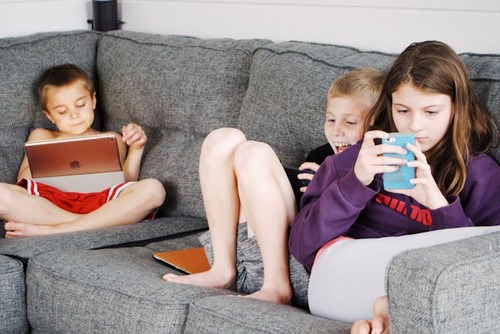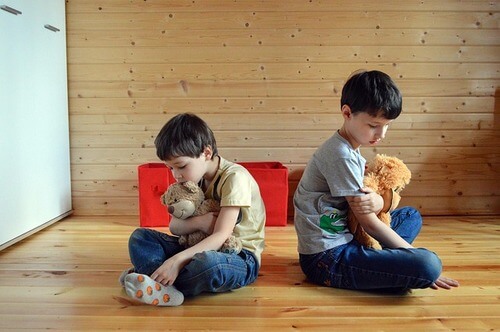Examples of Positive Discipline
Parenting guides and articles often give us lists of “common parenting problems and solutions.” They can be very helpful, but sometimes what you may need most is to hear a real story—examples of positive discipline techniques, something that makes us say, “Oh wow, I’ve been there too!”

No matter how picture-perfect things may look from the outside, parenting problems happen in every household.
And while every family is unique, many struggles are surprisingly common: screen time battles, sibling rivalry, homework wars, or the quiet distance that creeps in with teens.
The following examples of positive discipline are from real-life parents who have learned to deal with everyday problems.
You might not want to copy their solution exactly, but it is my hope that these stories will spark ideas and reassurance for you.
Examples of Positive Discipline #1. The Screen Time Struggle
Sarah, a mom of two—Liam (7) and Ava (10)—was overwhelmed by how much time her kids spent on tablets. Homework was delayed, dinners were silent, and bedtime turned into constant negotiations.
At first, Sarah went with the “strict mom” approach and confiscated the devices. The result? Tears, tantrums, and slammed doors. Being strict was obviously not the solution.
Then she realized it wasn’t about eliminating screens completely, but about teaching balance. So, she tried something new: a family media agreement.
Together, they set rules like no screens during meals, homework before gaming, and a “wind-down hour” before bed. Sarah also committed to putting her own phone away at dinner to model the same behavior.
Within a few weeks, the atmosphere at home shifted. Bedtime went smoother, Liam and Ava started playing outside again, and family conversations returned.
Sarah’s biggest takeaway? When kids are part of the decision-making, they’re more willing to stick to the plan.
Examples of Positive Discipline #2. The Sibling Rivalry Meltdown
James and Maria often joked that their kids, Ella (8) and Noah (6), loved each other fiercely—except when they didn’t.
One minute they were laughing together, the next they were fighting over who had the “better Lego piece.”
In the beginning, James and Maria constantly played referee, stepping in to declare who was right or wrong. But the fights never stopped.
They realized their approach wasn’t helping the kids learn how to resolve conflicts on their own. So they changed tactics.
 Not Ella and Noah
Not Ella and NoahThe next time a fight broke out, James asked both kids, “What’s a solution that feels fair to both of you?” At first, it was chaos—they shouted louder than ever.
But with coaching, they started brainstorming: taking turns, swapping toys, or choosing a different activity.
Meanwhile, Maria started giving each child one-on-one time—baking with Ella and bike rides with Noah. With individual attention, both kids felt valued without competing for approval.
The rivalry didn’t vanish (what siblings don’t argue?), but the fights became less explosive. Over time, Ella and Noah even started solving little disputes without their parents’ help.
Examples of Positive Discipline #3. The Teen Communication Wall
Lisa, a single mom, was heartbroken when her once-chatty son, Alex (15), became distant.
He spent hours behind closed doors, answered her questions with grunts, and barely looked up from his headphones. Lisa missed their closeness and worried she was being “shut out.”
At first, she tried to force conversations: “Tell me what’s wrong!” or “Why don’t you talk to me anymore?” But Alex only pulled away further.
That’s when Lisa realized that instead of pushing harder, she needed to start showing up differently.
She began joining Alex in his world—watching his favorite shows, grabbing burgers after school, and simply being present without interrogation.
Most importantly, she practiced listening without judgment. When Alex mentioned feeling stressed about a test, she fought the urge to lecture and simply said, “That sounds tough. How can I support you?”
It wasn’t instant magic, but little by little, Alex began to open up again. Lisa discovered that connection with teens isn’t built through big dramatic talks—it’s built in everyday moments of respect and presence.
Examples of Positive Discipline #4. The Homework Battle
Raj and Priya’s daughter, Anika (10), dreaded homework—and so did her parents. Evenings were filled with procrastination, nagging, and tears.
By the time the math worksheet came out, everyone’s patience was gone.Tired of the nightly stress, they tried something new: structure plus encouragement.
They created a homework routine—a short play break after school, a healthy snack, and then homework at the same spot every day.
To make it positive, they added small rewards: if Anika stayed focused, she got to pick the family’s Friday night activity.

Priya also changed her role from “enforcer” to “coach.” Instead of hovering or fixing every mistake, she stayed nearby for support and praised Anika’s effort: “I can see you’re really thinking hard about this problem.”
Within weeks, the tension melted. Anika began approaching homework with more confidence, and evenings became far less stressful. The surprising part?
Priya admitted the biggest shift wasn’t in Anika—it was in herself. By letting go of control and focusing on encouragement, homework time became a chance to connect instead of clash.
Final Takeaway
Find what works for your family, and give yourself permission to adjust along the way.






















New! Comments
Have your say about what you just read! Leave me a comment in the box below.